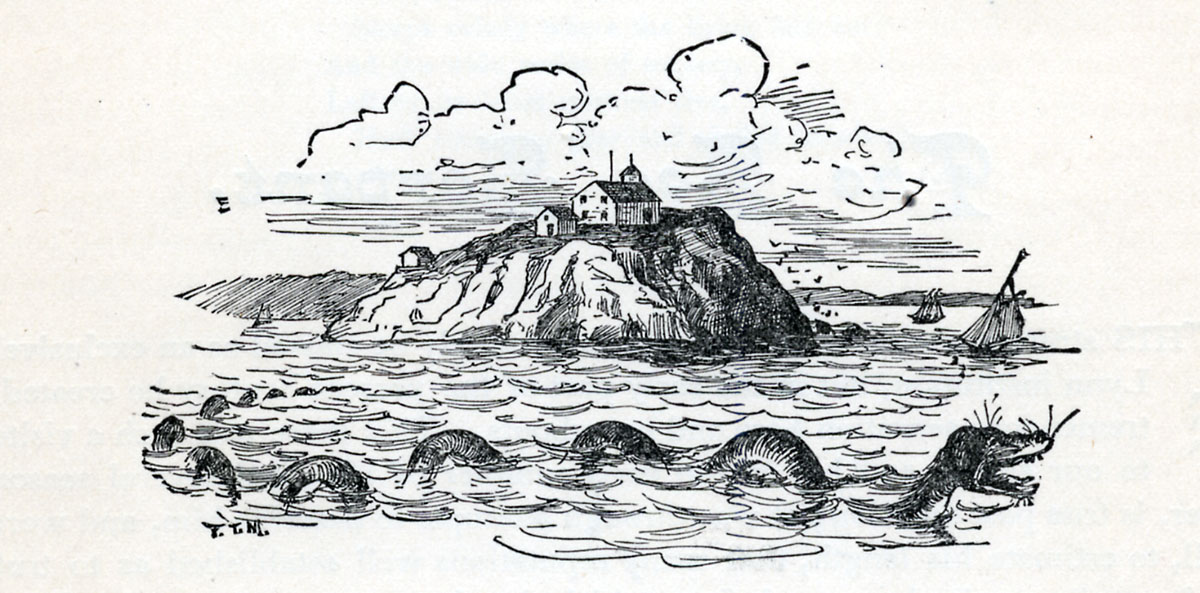
Ahoy, Captain Joshua Card here, down at Portsmouth Harbor Light in my home town of New Castle, New Hampshire. Winter’s been hanging on tight but spring is just around the corner, so they tell me. Today I’d like to tell you about an interesting fellow who kept the old Egg Rock Lighthouse down the coast off Nahant, Massachusetts: George L. Lyon.

The three-acre rocky island known as Egg Rock, almost a mile off Nahant, resembles a whitish-gray whale rising up about 80 feet out of the ocean. It got its name because of the large number of gulls’ nests there. The original lighthouse on the island was established in 1856 largely to help the local fishermen in Nahant and Swampscott; the station was rebuilt in 1897 with a square brick tower attached to the keeper’s house.

George L. Lyon, who grew up in nearby Lynn and was previously an assistant at Minot’s Ledge Lighthouse, became the keeper at Egg Rock in 1889. A large and athletic man, Lyon loved the sea and was on a lifesaving crew on Lake Erie by the age of 21.
The artist and writer Charles A. Lawrence of Lynn visited Egg Rock in 1891. He described Lyon: “Bronzed and blue-shirted, his yellow beard suggested the Norseman of old. I would not have been surprised to see him raise a drinking horn from somewhere and shout, ‘SKOAL!'”
Lawrence wrote about a tour of the light station with Lyon and his mother, who was then nearly 90. They also met the station’s housekeeper, Ada Foster, who was 15 at the time of their visit. During a tour of the lighthouse, the keeper jokingly told Lawrence, “Lots of people ask us what makes the light red, and we tell ’em it’s the red oil. Some of ’em don’t get it, and they say, ‘Oh, that’s it. I never knew.’” (The light was actually made red by the placement of a red glass chimney around the lamp.)

In the summer, there were countless visitors to Egg Rock. Lyon grew tired of people asking him if he longed for life on the mainland, and took to wearing a sign on his back that said, “No, thank you, I am not the least bit lonesome.” He was an avid reader, especially of scientific and technical books.
Keeper Lyon was a carpenter, boat builder, an expert marksman with a rifle, and an authority on firearms and explosives. He developed a well-equipped machine shop in the island’s boathouse. His mechanical aptitude enabled him to repair the dory engines of many local fishermen, and he invented a new type of crankshaft for boat engines that saved on gasoline. His crowning achievement at Egg Rock was the building of a landing stage on the island. With this arrangement, a boat would be hoisted out of the water onto a deck, then hoisted again into the boathouse. A powerful hand winch was used for both hoists.

Lyon was responsible for countless rescues in the vicinity of Egg Rock during his 22 years there. Once, after the keeper saved a group of five men, they took up a collection and presented a not-so-generous reward of 85 cents to their savior.
Keeper Lyon had a Newfoundland dog with the strange name of “O-who.” O-who loved to fetch sticks thrown by the keeper into the waves, and he rode along and “assisted” in some of the rescues around the island. Charles Lawrence called O-who a “sailor at heart.”
Lyon and his housekeeper, Ada Foster, developed a friendship that grew into romance over the years. Charles Lawrence wrote that Ada blossomed from a slender girl and developed a “robust physique that enabled her to bear a hand at the winch in hoisting the boats, an accomplishment which in no wise detracted from her fine skills as a cook and entertainer.” After leaving Egg Rock in 1911, Lyon became keeper at Graves Lighthouse in Boston Harbor, then at Nobska Point at Woods Hole on Cape Cod. The keeper and Ada planned to marry, but Ada died before the marriage could take place, while Lyon was at Nobska Point.

The light on Egg Rock was converted to automatic operation in 1919 and the keeper’s house was sold at auction, with the stipulation that the buyer had to move it to the mainland. As the house was being moved down the slope toward a waiting barge, a cable snapped and the building careened into the ocean. For some time, remains of the dwelling washed up on local beaches. The brick lighthouse tower stood until 1927 when it was destroyed.
*********************

Jeremy D’Entremont is the author of more than 20 books and hundreds of articles on lighthouses and maritime history. He is the president and historian for the American Lighthouse Foundation and founder of Friends of Portsmouth Harbor Lighthouses, and he has lectured and narrated cruises throughout the Northeast and in other regions. He is also the producer and host of the U.S. Lighthouse Society podcast, “Light Hearted.” He can be emailed at Jeremy@uslhs.org

